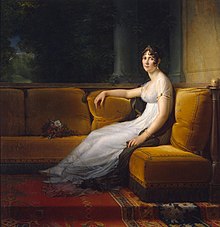Chemise dress

The chemise dress or simply the chemise ( French chemise 'shirt') was in the fashion of the Directoire and Empire a long women's dress made of thin, transparent fabric ( muslin ) in a simple, tunic-like cut (therefore also known as a tunique in French around 1800 marked), which was usually gathered under the chest with a ribbon or a belt and otherwise falls freely without a waist.
In German, the chemise is also called a shirt dress , a distinction then being made between the shirt dress worn as outer clothing in ancient Egypt and the shirt dress popular in the 1950s . In modern usage, chemise refers to different forms of hanging clothes , which are typically made of fine, thin fabric (e.g. silk) and cut relatively freely.
The historical chemise is the typical piece of clothing associated with fashion à la grecque . It appeared when the silhouette changed in France during the period of the Revolution by abandoning the crinoline and bodice . Chemise fashion was prepared by the already existing predilection for muslin, for example in the shepherd's costumes of Marie Antoinette and by the enthusiasm for antiquity, which followed the excavations in Pompeii in England in the 1780s, and the desire for antiquity that followed To imitate drapery.
Since white was mistakenly believed to be the color of antiquity, the chemise dresses were made of white fabric, the most colorful accents there was a chest band, preferably in pink or pale blue, some floral embroidery or a meander band on the hem. In addition to muslin, other cotton fabrics in plain weave ( batiste , calico , linon), linen , net-like fabrics ( gauze , tulle , lace over taffeta ) or - especially in France Napoleon Bonapartes - also silk were used as fabric . Until the 1800s, the chemise , which until then was an elaborate item of clothing due to the amount and quality of fabric required and therefore reserved for women in the upper class, often had a train.
Following Napoleon's Egyptian campaign , the tunique à la Mameluck became popular in France . After the fall of Napoleon, the fashion changed in the direction of stronger veiling: the drawstring fell away and was replaced by a dress button or lacing on the back, the fabric was slightly stiffened and fell smoothly to the now ankle-length hem, which was previously only hinted at Sleeves became longer and puffed or one wore long sleeves with upper arm puffs à la Renaissance . In the transition to the Biedermeier period , the décolleté became much more economical and ended with a stiff ruff or a zigzag band ( dent de loup "wolf's tooth"). The previously very simple fabric was given a lush finish in the form of borders , ruffles , zigzag ribbons and artificial flowers . Only the ball gown retained the Empire style, remained simple with an often shoulder-free cleavage and also retained the train ( cour train ).
Chemise fashion has been caricatured many times, here “Parisian winter fashion for 1800” by Isaac Cruikshank
The so-called Rice Portrait : young lady with a chemise , possibly a representation of the young Jane Austen .
Revealing necklines weren't uncommon.
Chemise with a short train, a capot on the stand ( Journal des Dames , 1799).
The chemise was fashionable all over Europe, here the Condessa de Casa Flores, portrayed by Francisco Goya .
Tunique à la Mameluck and Titus head 1803
literature
- Ingrid Loschek : Reclam's fashion and costume lexicon. 5th edition Reclam, Stuttgart 2005, ISBN 3-15-010577-3 , pp. 144-146
- Erika Thiel: History of the costume: European fashion from the beginning to the present . Henschel, Berlin 2004, ISBN 3-89487-260-8 , p. 136.







